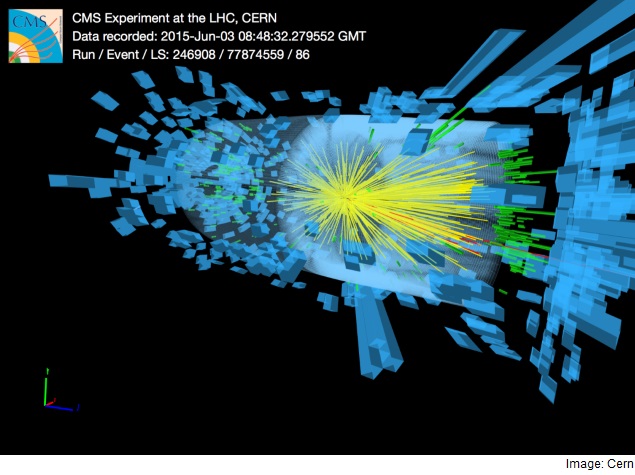- Home
- Science
- Science News
- Scientists Hail 'New Era' in Physics as Large Hadron Collider Cranks Up
Scientists Hail 'New Era' in Physics as Large Hadron Collider Cranks Up

The tests with collisions of 13 teraelectonvolts (TeV) came after a sweeping two-year revamp of the Large Hadron Collider (LHC), used to prove the existence of the Higgs Boson which confers mass and is also known as the God particle.
The European Organisation for Nuclear Research (Cern) said everything went according to plan at the giant lab, a 27-kilometre (17-mile) ring-shaped tunnel straddling the French-Swiss border.
"It is time for new physics!" declared Cern's outgoing director general Rolf Heuer.
"We have seen the first data beginning to flow. Let's see what they will reveal to us about how our universe works," he said.
"It's not going to happen tomorrow, be patient," he said.
"I am happy, I am touched, I am proud to be the boss of this organisation," he added, as the collision drew sustained applause from scientists monitoring the event.
On May 20, the LHC broke the record for energy levels colliding protons at 13 TeV for the first time.
The LHC's previous highest energy for collisions was eight TeV, reached in 2012 before it closed for a thorough upgrade.
Experiments at the collider are aimed at unlocking clues as to how the universe came into existence by studying fundamental particles, the building blocks of all matter, and the forces that control them.
Unlocking nature's secrets
"The collisions we are seeing today indicate that the work we have done in the past two years to prepare and improve our detector has been successful and marks the beginning of a new era of exploration of the secrets of nature," said Tiziano Camporesi, a spokesman for the project.
The LHC was used to prove the existence of the Higgs Boson, a discovery that earned the 2013 Nobel physics prize for two of the scientists who had theorised the existence of the Higgs back in 1964.
The LHC allows beams containing billions of protons travelling at 99.9 percent the speed of light to shoot through the massive collider in opposite directions.
Powerful magnets bend the beams so that they collide at points around the track where four laboratories have batteries of sensors to monitor the smashups.
The sub-atomic rubble is then scrutinised for novel particles and the forces that hold them together.
One teraelectronvolt is roughly equivalent to the energy of motion of a flying mosquito, Cern says on its website.
But within the LHC, the energy is squeezed into an extremely small space about a million, million times smaller than a mosquito. It is this intensity which causes the particles to be smashed apart.
During the next phase of the LHC programme, researchers will probe a conceptual frontier called new physics, including antimatter and dark matter.
The latter is a theoretical type of matter that cannot be seen with telescopes but is thought to make up most of the universe. It has only been detected by its gravitational effects, Cern says.
Ordinary, visible matter comprises only about four percent of the known universe.
As part of the recommissioning process, LHC engineers successfully introduced two proton beams, the source material for sub-atomic smashups.
For the latest tech news and reviews, follow Gadgets 360 on X, Facebook, WhatsApp, Threads and Google News. For the latest videos on gadgets and tech, subscribe to our YouTube channel. If you want to know everything about top influencers, follow our in-house Who'sThat360 on Instagram and YouTube.
Related Stories
- Samsung Galaxy Unpacked 2025
- ChatGPT
- Redmi Note 14 Pro+
- iPhone 16
- Apple Vision Pro
- Oneplus 12
- OnePlus Nord CE 3 Lite 5G
- iPhone 13
- Xiaomi 14 Pro
- Oppo Find N3
- Tecno Spark Go (2023)
- Realme V30
- Best Phones Under 25000
- Samsung Galaxy S24 Series
- Cryptocurrency
- iQoo 12
- Samsung Galaxy S24 Ultra
- Giottus
- Samsung Galaxy Z Flip 5
- Apple 'Scary Fast'
- Housefull 5
- GoPro Hero 12 Black Review
- Invincible Season 2
- JioGlass
- HD Ready TV
- Laptop Under 50000
- Smartwatch Under 10000
- Latest Mobile Phones
- Compare Phones
- Redmi Turbo 4
- Vivo Y200+
- Lava Yuva 2 5G
- OnePlus Ace 5
- OnePlus Ace 5 Pro
- Oppo A5 Pro 5G
- Vivo Y29 5G
- Honor Magic 7 RSR Porsche Design
- Asus Zenbook S 14
- MacBook Pro 16-inch (M4 Max, 2024)
- Honor Pad X9 Pro
- Honor Pad V9
- boAt Enigma Gem
- boAt Enigma Daze
- Sony 65 Inches Ultra HD (4K) LED Smart TV (KD-65X74L)
- TCL 55 Inches Ultra HD (4K) LED Smart TV (55C61B)
- Sony PlayStation 5 Pro
- Sony PlayStation 5 Slim Digital Edition
- Blue Star 1.5 Ton 3 Star Inverter Split AC (IC318DNUHC)
- Blue Star 1.5 Ton 3 Star Inverter Split AC (IA318VKU)

















